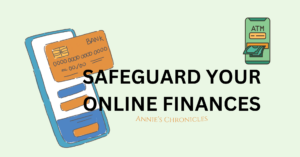Safeguard Your Online Finances
Conducting financial transactions online is the norm now. From mobile banking to online shopping, digital technologies have revolutionised the way we manage our finances. However, along with the convenience comes a host of cybersecurity risks that can threaten our financial security. This blog will shed some light on the growing threats posed by cybercriminals and give you actionable steps to take to protect yourself.
The Rise of Cybersecurity Risks:
One of my friends—let’s call her Sandra—is a young professional who relies on online banking to manage her finances. One day, she receives an email from what appears to be her bank, asking her to verify her account information due to a “security breach.” Without giving it a second thought, Sarah clicks on the link and enters her login credentials, unknowingly falling victim to a phishing scam. Within hours, her bank account is drained, and she is left grappling with the aftermath of financial fraud.
I’m sure we’ve come across many stories like Sandra’s. This is just one example of the variety of cybersecurity risks that we face in today’s digital age. As more financial transactions move online, cybercriminals are finding increasingly sophisticated ways to exploit vulnerabilities and steal sensitive information. From phishing attacks and malware infections to data breaches and identity theft, the threats are ever-evolving and potentially devastating.
Protecting Yourselves:
So, how can you safeguard your finances and protect yourself from falling prey to cyber threats? Here are some essential steps to take:
1. Stay Vigilant Against Phishing Attempts: Be wary of unsolicited emails, texts, or phone calls requesting sensitive information. Verify the legitimacy of the sender before clicking on any links or providing personal data.
2. Use Strong, Unique Passwords: Avoid using easily guessable passwords and refrain from using the same password across multiple accounts. Opt for complex combinations of letters, numbers, and symbols, and consider using a reputable password manager to securely store and manage your passwords.
3. Enable Multi-Factor Authentication (MFA): Add an extra layer of security to your accounts by enabling MFA wherever possible. This typically involves verifying your identity through a secondary method, such as a one-time code sent to your mobile device, in addition to your password.
4. Keep Software and Devices Up to Date: Regularly update your operating system, antivirus software, and applications to patch security vulnerabilities and protect against emerging threats.
5. Be Cautious When Using Public Wi-Fi: Exercise caution when accessing financial accounts or conducting sensitive transactions on public Wi-Fi networks, as they may be vulnerable to interception by cybercriminals. Consider using a virtual private network (VPN) for added security.
6. Monitor Your Accounts Regularly: Keep a close eye on your bank and credit card statements for any suspicious activity, and report any unauthorised transactions to your financial institution immediately.
By staying informed about the latest cybersecurity threats and implementing proactive security measures, you can reduce the risk of falling victim to financial fraud and protect your hard-earned money. Remember, when it comes to cybersecurity, vigilance is key.

